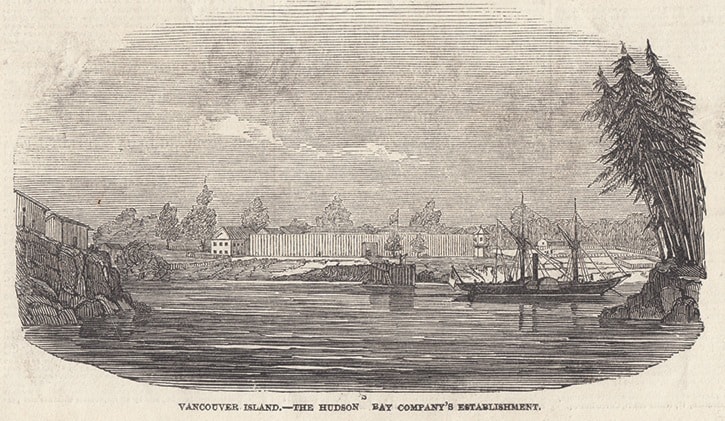In late November 1848 the docks from London to Gravesend were crowded with vessels and goods arriving from all parts of the Empire. Warehouses along the Thames housed sugar from the West Indies, coffee from Brazil and supplies awaiting shipment to the colonies.
One of the ships in port was the Harpooner, preparing to sail with the first contingent of settlers to Vancouver Island. Twenty-one year old Andrew Muir, of Scotland, made his way to the offices of the Hudson’s Bay Company on Fenchurch Street where he was warmly received by the Company’s Governor. Muir, together with his father and brothers, had replied to the HBC’s advertisement in Ayrshire, Scotland for experienced miners for the Company’s coal operations on Vancouver Island.
As the Harpooner departed in early December on its six month voyage to the NW Coast, Muir chronicled in his diary the beauty of the “bright shining moon on the rolling waves of the Mighty Deep.” Five months later – still at sea on the crowded ship with limited rations and tensions growing between the passengers – he wrote how they were “all beginning to weary now to get to Vancouver [Island].”
Among the passengers aboard the Harpooner were several Scottish labourers hired by Captain Walter Colquhoun Grant. Grant was born to a prominent family in Scotland in the early 1820s and had followed a military career. In 1848, hearing of the HBC’s lease of Vancouver Island, he borrowed funds from an uncle and set off via Panama, arriving at Fort Victoria in August 1849, several weeks after the Harpooner. Expecting to find property near the fort, Grant was instead directed by James Douglas to Sooke, a wilderness 25 miles distant and accessible only by water.
Two letters written by Grant in 1848-49 and uncovered recently by staff at the National Records of Scotland, reveal his attempts to recruit labourers from among his Scottish clan. Grant wrote to Lord Seafield, clan chief, asking for men to accompany him “for some years to a region which though distant, is in climate and other respects much assimilated to Great Britain.”
Grant named his Sooke estate ‘Mullachard’ after Lord Seafield’s lands at Strathspey, Scotland. His ambition as a country gentleman on the frontier met with little success, however, and he left the colony in 1853, selling his land to the Muir family.
Also aboard the Harpooner was James Yates, a ship’s carpenter, and his wife Mary. The couple had married in Scotland two weeks before the Harpooner set sail and their first child was born at Fort Victoria in 1850. Yates was hired on a three-year contract with HBC but his entrepreneurial spirit was better suited to private enterprise. In January of 1851 he secured the colony’s first retail liquor license and established a successful business. With the profits he purchased more than 300 acres of land along the Gorge waterway in Saanich.
Caroline Duncan researches and writes about local history. She is the archivist at Saanich Archives.
